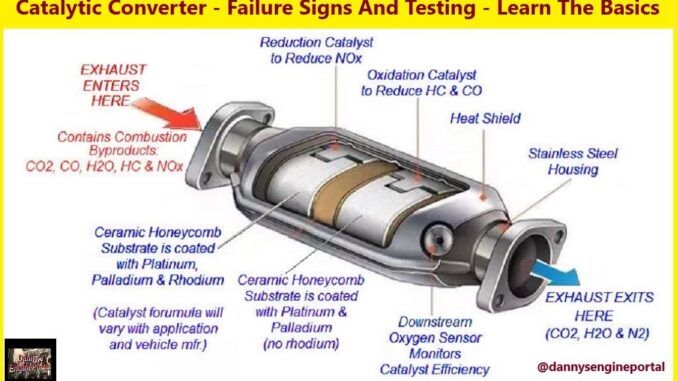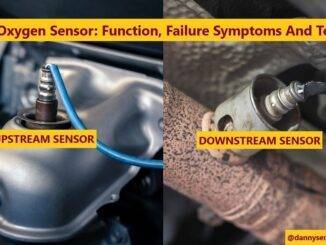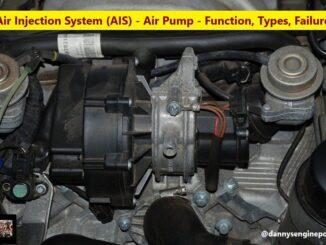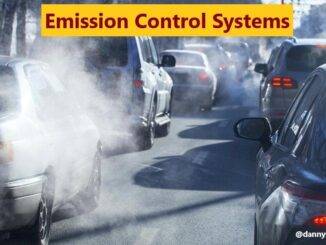
So, a catalytic converter, is a device used to reduce the emissions, from an internal combustion engine.
Consequently, the catalytic converter works, by breaking down unburned gases, left over by the combustion process. And, requires you to use, unleaded fuel.
This is because the lead in conventional fuels, “poisons” the catalyst, preventing the catalytic converter from working on the pollutants. And, they only work at high temperatures, when the engine has had chance to warm things up.
Above all, without a catalytic converter, your vehicle will no longer be filtering and reducing harmful emissions. Including, hydrocarbons, nitrogen oxides, and carbon monoxide.
Knowing The Basics
The exhaust from the engine gets filtered through this device, so harmful chemicals can be removed like:
- Carbon monoxide (a poisonous gas)
- Nitrogen oxides (a cause of smog and acid rain)
- Hydrocarbons (a cause of smog)
But, a bad (O2) sensor, can feed wrong information to the computer, which can affect the performance of catalytic converter.
Consequently, too rich a fuel mixture, causes unburnt fuel to enter the catalytic converter. Then, at some point it will be damaged, due to thermal shock.
So, inside the converter, the gases flow through a dense honeycomb structure. And, is made from a ceramic and coated with the catalysts. Also, by using a honeycomb structure, the area is greatly increased.
Check Engine Light And Codes
The (CEL) or (MIL), is your best friend, when dealing with emission problems.
So, whenever this light comes on, check for (DTC). The common catalyst failure codes are, P0420 or P0430.
Signs Your Catalytic Converter May Be Failing
The most common signs include:
- Poor acceleration, when stepping on the gas pedal.
- Engine misfiring.
- Noticeably, less fuel efficiency.
- Dark, sooty smoke exiting your exhaust.
- Engine starting trouble.
- Failing an emissions test.
- A pungent sulfuric or rotten egg smell.
- A (CEL), in conjunction with any of these other symptoms.
If the exhaust system is restricted, it may be the result of another underlying problem. The following are the most common causes of catalytic converter failure:
- Poor engine performance or an overly rich air fuel mixture. This can cause the converter to overheat, causing the substrate to melt down. One sign of this is a converter that is red hot. Symptoms include, loss of power at high engine speeds, a hissing noise when accelerating. Also, prolonged cranking, and poor acceleration and fuel economy.
- Leaded fuels can also cause the converter to overheat and the substrate to fail.
- Coolant leaking into the exhaust system or silicone from sealants can coat the catalyst, and render it useless. If the exhaust system has had coolant or silicone contamination. Then, the (O2) sensor and catalyst will have a white coating or glaze that should be visible.
Testing For A Blocked Or Clogged Catalytic Converter
Using A Vacuum Tester
So, an exhaust system restriction, will cause a loss of engine power. But, so can many other problems. If you suspect a clogged up converter, you will need to test the system. This test requires you having a vacuum gauge. So, if you don’t have one, consider buying one. Because, a vacuum gauge is a useful diagnostic tool, that will come in handy in other repair projects.
These are the steps for testing:
- Set the transmission to park (automatic) or neutral (manual), and apply the parking brake.
- Then, connect the vacuum gauge, to a direct intake manifold port.
- Start the engine and let it idle for about 15 to 20 minutes, so that it reaches operating temperature.
- At idle, the vacuum reading should be, between 18 and 22 in Hg. (inches of Mercury)
- Increase and hold the (RPM) to about 3000. The vacuum reading should drop. But, should go back to the previous level in a few seconds. If not, it’s likely the exhaust system is blocked. Continue to the next step.
- Repeat the test, but this time, snap the throttle valve open about four times.
- While rising the engine speed to about 2500 (RPM). Take note of the vacuum reading, with each snap of the throttle.
- If you see the gauge needle, dropping steadily to near zero. Then, most likely the catalytic converter or muffler is restricted.
To confirm a possible restriction, loosen the back pipe from the catalytic converter. But, just enough to allow gas to flow through.
Repeat step 6. If the vacuum doesn’t drop considerably this time, you’ve found the blockage (back pipe or muffler). Otherwise, go to the next step.
Loosen the header exhaust pipe from the converter, just enough to allow exhaust gas to flow through.
Repeat step 6 and take note of your vacuum readings. If your vacuum readings show normal vacuum. Then, the converter is restricted or clogged up.
Using A Back Pressure Tester
Just like the vacuum test above, a back pressure test can help you diagnose a clogged exhaust system. This test is done directly at the exhaust system, to detect a clogged catalytic converter or muffler or pipe. This simple test, requires a back pressure gauge.
NOTE: This test is easy to do, as long as you don’t break off a (O2) sensor. (The use of heat or penetrating oil, and a back and forth motion may help, if the threads are rusty).
First, remove the back (O2) sensor. This sensor is usually located directly after the converter. Most (O2) sensors use an 18mm threaded port. So, one adapter fits many applications. Install the adapter in the (O2) port, and tighten to manufacturer specs.
Then, connect the gauge hose to the adapter. Begin by reading and taking note of the pressure at idle, and at 2500 (RPM). On most vehicles, idle back pressure should not be higher than 1 (PSI). At 2500 (RPM), the reading should not be higher than 3 (PSI). If the readings are high at this point, the blockage probably exists downstream of the test point. And, usually means it is in the muffler or resonator.
If the back pressure is okay at this location, move to the (O2) sensor just ahead of the converter. And, if the back pressure is high at this point, the converter is causing the issue. If the (O2) sensor ahead of the converter tests okay, then the restriction is most likely in the y-pipe. But, there could also be an internal restriction in the air gap pipe. It is located, between the exhaust manifold and the converter.
Checking Temperature With A Infrared Thermometer
Just like the back pressure test above, a temperature test can help you diagnose a clogged exhaust system. This test is done directly at the exhaust system. And, detects a clogged catalytic converter, muffler or pipe. This simple test, requires a infrared thermometer.
In a good catalytic converter, the rear of the converter will be, 20 degrees hotter than the front.
The best way to do a temperature check, is by using an infrared thermometer. Here are the steps:
- Switch on the engine and let it idle for 20 minutes. This allows it to rise to its normal temperature. You can also take the car for a short drive on the road or highway then come back.
- Leave the engine idling and set the car in park. (or neutral for a manual)
- Check if you have enough clearance to get under the car. If you don’t, raise the front of the car and support it on jack stands. The catalytic converter is usually located close to the engine, so you only need to raise the front. Place blocks against the rear wheels for added safety.
-
A infrared thermometer is a must.
- Take an infrared thermometer and measure the temperature at the front of the catalytic converter. You only need to measure the surface temperature, so an infrared thermometer is perfect. It also allows you to maintain a safe distance from the hot converter.
- Make sure you hold the infrared thermometer at the right distance, from the point whose temperature you are taking. A distance of about 12 cm away from the surface of the converter, will give you an accurate reading.
- Record the front reading then measure the temperature at the rear of the converter and record it as well.
Comparing the two readings will tell you whether your car’s catalytic converter is working as expected.
If the front and rear readings are similar or almost the same, there’s a problem. And, if the front temperature is higher than the rear temperature, there’s a problem.
But, if the rear temperature of the catalytic converter is 20 or more degrees hotter than the front. Then, your catalytic converter is likely okay. If you are still experiencing problems with the engine and exhaust, check the muffler.
A working catalytic converter will have hotter gasses coming out at the rear, compared to the exhaust gasses coming in.
If you get a lower rear temperature, it’s likely that the catalyst inside has deteriorated. And, is not converting exhaust gasses or it is clogged up.
Using A Pressure Transducer
Just like the temperature test above, a back pressure test can help you diagnose a clogged exhaust system. This test is done directly at a cylinder, to detect a clogged catalytic converter or muffler or pipe. This simple test, requires a pressure transducer.
This is where for some it gets a little tricky. Unless you have some experience at reading waveforms, it might be best to watch a video. There are tons out there. Good luck!
Knowing The Basics
Worn spark plugs, or burned and leaking exhaust valves, allow unburned fuel into the exhaust system. Consequently, it ignites in the catalytic converter and melts the internals. A weak ignition system, can also cause the same problem, by not getting enough spark to the spark plugs.
In Summary: Catalytic Converter
So, catalytic converter problems, could also be something more serious. For instance, like heavily worn piston rings or a jumped timing chain. Consequently, these problems allow fuel or air, into the wrong place at the wrong time. Furthermore, a head gasket or intake manifold leak, can cause problems as well. Finally, oil or coolant can coat the catalyst, setting off a (CEL).
Thank You!




